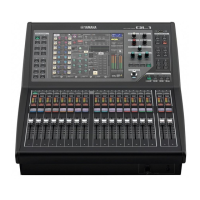Input channels
Reference Manual
35
If the MIX/MATRIX bus is a stereo bus
You can link the main parameters of two adjacent odd/even-numbered MIX/MATRIX
buses. If the send-destination MIX/MATRIX bus is assigned as stereo, the left knob of the
two adjacent TO MIX/MATRIX SEND LEVEL knobs will operate as the TO MIX/MATRIX
PAN knob. (If BALANCE mode is selected in the TO STEREO/MONO window, it will
operate as a BALANCE knob).
NOTE
• For an INPUT channel (monaural), the right knob will adjust the common send level to the two
MIX/MATRIX buses, and the left knob will adjust the panning between the two MIX/MATRIX
buses. Rotating the left TO MIX/MATRIX SEND PAN knob counter-clockwise will increase the
amount of signal sent to the odd-numbered MIX/MATRIX bus, and rotating it clockwise will
increase the amount sent to the even-numbered MIX/MATRIX bus.
• For a ST IN channel (stereo), if BALANCE mode has been selected in the TO STEREO/MONO
window (8ch), the right knob adjusts the common send level for the two MIX/MATRIX buses, and
the left knob adjusts the volume balance of the left and right signals sent to the two MIX/MATRIX
buses. Rotating the left TO MIX/MATRIX SEND BAL knob counter-clockwise will increase the
amount of signal sent from the L-channel to the odd-numbered MIX/MATRIX bus, and rotating it
clockwise will increase the amount sent from the R-channel to the even-numbered MIX/MATRIX
bus. If PAN mode has been selected in the TO STEREO/MONO window (8ch), the left knob will
function as the PAN knob. The right knob will function as send level, just as in BALANCE mode.
MIX SEND/MATRIX SEND window
1 ALL PRE button
Sets the send point to PRE. (The send point is the point at which signals are sent from
all send-source channels — including the input and output channels — to the selected
send destination.) At this time, the PRE/POST button will light.
2 ALL POST button
Sets the send point to POST. (The send point is the point at which signals are sent from
all send-source channels — including the input and output channels — to the selected
send destination.) At this time, the PRE/POST button will turn off.
3 Send destination indicator
Indicates the currently-selected send destination.
4 Send destination select buttons
Select MIX/MATRIX buses as the send destination.
5 Channel select button
Selects the send-source channel that you wish to control. The current channel icon,
number, and color appear on the button, and the channel name appears below the
button.
6 PRE/POST button
Switches the send point of each send-source channel between PRE and POST. If the
button is lit, the send point is set to PRE.
NOTE
• If the PRE/POST button is on, you can also select PRE EQ (immediately before the EQ) or PRE
FADER (immediately before the fader) for each MIX/MATRIX bus. This setting is made in the BUS
SETUP window (page 216).
• The PRE/POST button is not displayed for FIXED type MIX buses.
7 SEND ON/OFF button
Switches the send of each send-source channel on or off.
8 SEND PAN/BALANCE knob
Sets the panning or balance of signals sent to the stereo send destination. If the send
destination is monaural or set to FIXED, this knob will not appear.
If the send source is monaural, this knob functions as a PAN knob.
If the send source is stereo, you can use PAN/BALANCE mode setting
in the TO STEREO/MONO window to select whether PAN/BALANCE
will function as a PAN or BALANCE knob. The knob for the mode
selected here will appear.
13 32 1 2
9
7
6
5
4
9
8 8
7
6
5
4

